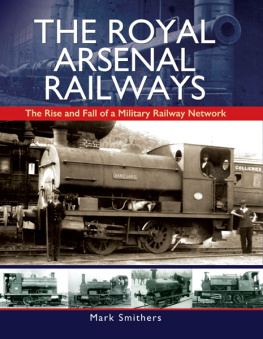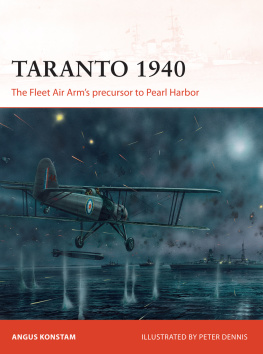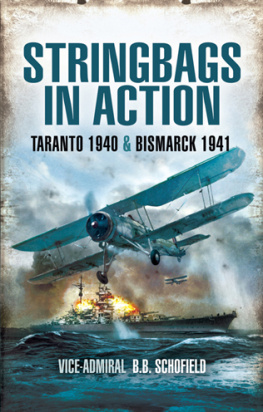TARANTO 1940
By the same author
THE MAN WHO DISOBEYED: Sir Horace Smith-Dorrien and
his Enemies
SIR JOHN MONASH
THE KAFFIR WARS 17791877
TOBY: A Real-life Ripping Yarn
DORNFORD YATES: A Biography
COMBINED FORCES
A NEW EXCALIBUR: The Development of the Tank
19091939
RUDE MECHANICALS: An account of Tank maturity during
the Second World War
HONOURABLE CONQUESTS: An Account of the Enduring
Work of the Royal Engineers throughout the Empire
CAMBRAI: The First Great Tank Battle 1917
THE FIGHTING NATION: Lord Kitchener and his Armies
TARANTO 1940
A Glorious Episode
by
A. J. SMITHERS
First published in Great Britain in 1995 by
LEO COOPER
190 Shaftesbury Avenue, London WC2H 8JL
an imprint of
Pen & Sword Books Ltd,
47 Church Street,
Barnsley, South Yorkshire S70 2AS
AJ Smithers, 1995
A CIP record for this book is available from the British Library
ISBN 0 85052 491 i
All rights reserved. No part of this publication may be
reproduced, in any form or by any moans, without permission
from the publishers.
Typeset in 11/12pt Linotype Sabon
by Phoenix Typesetting, Ilkley, West Yorkshire
Printed at Redwood Books, Trowbridge, Wiltshire.
CONTENTS
A n outsider with no more than an outsiders knowledge who attempts to write of operations carried out by the Fleet Air Arm must do so at his peril. I have been given far more help from the inside than I had any right to expect. Firstly, Mr Richardson of the Fleet Air Arm Museum at Yeovilton has been more than generous in furnishing me not only with information for which I had asked but much more besides; as often as not information that I did not know to exist. My debt to him and to Charles Stirling, himself formerly of the Museum, is something that I gratefully acknowledge. It was Mr Richardson again who took the risk of introducing me to one of the six gentlemen left who have firsthand experience of the exploits that make up the substance of this book. Lieutenant-Commander J.W.G. Wellham, DSC, RN (retd), himself the author of that splendid book With Naval Wings, is one of the Taranto Forty; he has, with great kindness and forbearance, gone to much trouble over answering questions, many of which must have seemed rather silly. In addition he generously assumed the burden of reading my typescript and red-inking it as it deserved. That, of course, does not imply that he bears the slightest responsibility for the contents of this book or any part of them.
My old and valued friends at the Imperial War Museum, Roderick Suddaby and Nigel Steel, were once more at pains to find for me everything in their Department of Manuscripts that bears upon this story and I am as grateful as I was on the first occasion, now long ago. His Excellency the Italian Ambassador was good enough to put me in touch with the Ufficio Storico della Marina Militate in Rome and I am much beholden to the officials there for finding the information needed about the other side of the hill. Mr McGowan, Archivist to the Royal Naval College at Greenwich, having ascertained that his sources lacked the information I requested, was good enough to suggest that I wrote to the Naval Historical Branch in Whitehall. I did. Twice. My letters were not answered.
Once again it is a pleasure to be able to put on record my debt to Philippa Arnott. Furnished with a heap of rudely-typed, much amended, A4 manuscript paper she has the rare ability, assisted now by some piece of up-to-date machinery beyond my understanding, to turn it into something almost beautiful. At any rate to this authors eye.
For what we are about to receive, thank God and the British Navy
Grace at the authors prep school
(and that of many others) 1920s.
I have some news for the House. It is good news. The Royal Navy has struck a crippling blow at the Italian fleet I felt it my duty to bring this glorious episode to the immediate notice of the House.
The Prime Minister
13 November, 1940
Just before the news of Taranto the Cabinet were rather down in the dumps; but Taranto had a most amazing effect upon them.
Letter, Admiral Sir Dudley Pound to
Admiral Sir Andrew Cunningham
Illustrious manoeuvre well executed.
Signal from Admiral Cunningham
12 November, 1940
T he season of autumn brings with it the greatest annual number of Service dinners and luncheons. Armistice Day, regrettably down-graded in this of all countries, must forever stand apart. Trafalgar Day has attained respectable antiquity. Cambrai Day, celebrated by the successors to the Tank Corps of 1917, is on the way to doing the same, for few of the combatants can still be with us. Since the Second World War another name of power has been added. On, or near to, 12 November the Fleet Air Arm dines ceremonially in order to remember its own greatest of days. It is pleasant to know that there are still living among us gentlemen who made their contributions to that victory.
The torpedo it got its name from a fish that gives electric shocks had been around since the time of the Franco-Prussian war and Mr Whitehead has had many imitators. His compressed-air-driven machine reached something like perfection before the Kaisers war, notching up speeds in the order of 30 knots. Inevitably, it was detested by the established navies, for it was, beyond argument, the means by which a very small ship could sink a very big one with a single blow. The only mitigating factor was that the upstart menace was ruinously expensive and only rich nations could afford it.
The weapon was a very sophisticated piece of Victorian machinery. From nose to tail it comprised the pistol, fitted with a safety device to prevent explosion before the due time, the warhead, the air chamber, the balance chamber worked by float and spring to ensure keeping proper depth, the propelling machinery and gyroscope, the buoyancy chamber, two contra-rotating screws and, finally, the tail. Such complication does not come cheaply. The torpedo was, of course, designed to be fired from one ship to another and not to withstand the rough usage of being dropped from a flying-machine. When the Wright brothers or their associates wished to make their aeroplane into a weapon of war it would have to use the cruder and, for a long time to come, far smaller bomb. In 1914 this meant something that could be picked up in one hand and tossed over the cockpit side. Though Captain Guidoni may not have wholly realized what he had done, he had completely altered the shape of sea warfare in the future. In 1911, still the distant future.
The story begins in the summer of 1911, one of the hottest of the century. At home a new King, trained to the sea, and his Queen were being crowned with all the ancient panoply. Their dockyards, and those of their cousin of Germany, were clanging day and night as the rivetters put together some of the biggest battleships ever built and experts of one kind and another devised plans for blowing them all out of the water. The best way, everybody agreed, was to provide your ship with guns bigger and further-ranging than anything that your enemy could manage, for such was the tradition of all navies since gunpowder had come in. There were other methods. The floating or moored mine confusingly called a torpedo in its early days had been in service since the Crimean War. It was not highly regarded, for it was the weapon of the weaker power, but there was no denying its usefulness as a means of defence. Then there was the torpedo, properly so called.











